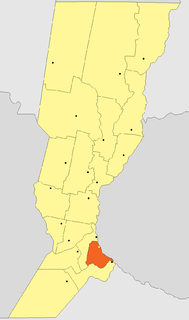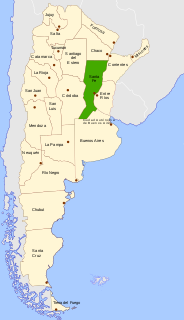
Rosario is the largest city in the central Argentina province of Santa Fe. The city is located 300 km (186 mi) northwest of Buenos Aires, on the west bank of the Paraná River. Rosario is the third most populous city in the country, and is also the most populous city in Argentina that is not a provincial capital. With a growing and important metropolitan area, Greater Rosario has an estimated population of 1,276,000 as of 2012. One of its main attractions includes the neoclassical architecture that has been retained over the centuries in hundreds of residences, houses and public buildings.
Ariel José Graziani Lentini is a former football player. He is a naturalized Ecuadorian striker who represented the Ecuador national team on 34 occasions between 1997 and 2000. After retiring in Ecuador he is only able to play amateur football, he has chosen to play for Argentinian fifth-level club Atlético Empalme since May, 2007.

Futaleufú is a department in the north west of Chubut Province, Argentina. Its main town and capital is Esquel to the north, with Trevelin and El Corcovado as the only other towns of significant size. Other settlements are Cerro Centinela, Aldea Escolar, Los Cipreses and Lago Rosario. The population of the department is 37,500 inhabitants as per the 2001 census [INDEC], which represents a population density of fewer than 4 inhabitants/km².

The Rosario Department is an administrative subdivision (departamento) of the province of Santa Fe, Argentina. It is located on the south of the province, with its eastern border coinciding with the provincial border along the Paraná River. It has an area of 1,890 square kilometres (730 sq mi) and a population of 1.3 million, with a population density of about 700 inhabitants/km². This department is the most populated in the province.

San Nicolás de los Arroyos is a city in the province of Buenos Aires, Argentina, on the western shore of the Paraná River, 61 km (38 mi) from Rosario. It has about 133,000 inhabitants. It is the administrative seat of the partido of the same name. It is sometimes called Ciudad de María due to a series of Marian apparitions that led to the erection of the Sanctuary in honor of Our Lady of the Rosary of San Nicolás that began during the 1980s and were approved by Bishop Cardelli of the diocese as "worthy of belief" in 2016.

The Ludueña Stream is a small river in the province of Santa Fe, Argentina, which starts near the city of Rosario and flows through it, mostly east-southwards, ending in the Paraná River in the neighbourhood commonly known as Arroyito, near Rosario Central's football stadium.

Casilda is a city in the province of Santa Fe, Argentina. It is the head town of the Caseros Department, and lies about 45 km (28 mi) west of Rosario and 202 km south-southwest of the provincial capital Santa Fe, on National Route 33. It has a population of about 35.058 inhabitants.

Campana is a city in the province of Buenos Aires, Argentina. It is the seat of the Campana Partido. It is located about 75 km (47 mi) from the Autonomous City of Buenos Aires, on the right-hand margin of the Paraná River. Its population is 94,333 inhabitants as per the 2010 census [INDEC].

The San Lorenzo Department is an administrative subdivision (departamento) of Santa Fe Province, Argentina. It is located in the south of the province. It limits with the populous Rosario Department and the Paraná River in the east; and from there with the departments of Constitución (south), Caseros (east), Iriondo and San Jerónimo (north).

Villa Ángela is a city in the province of Chaco, Argentina, 186 km west of the provincial capital Resistencia. It is on the Gran Chaco, a lowland region of the Río de la Plata basin. It has 43,511 inhabitants as per the 2001 census [INDEC], making it the third largest in the province.

The Constitución Department is an administrative subdivision (departamento) of the province of Santa Fe, Argentina. It is located on the south of the province. It has about 83,000 inhabitants as per the 2001 census [INDEC]. Its head town is the city of Villa Constitución.

The Buenos Aires–Rosario–Córdoba high-speed railway was a project designed to link the Argentine cities of Buenos Aires, Rosario and Córdoba through a 710 km (440 mi) high-speed rail network. The plan, announced by then-President Néstor Kirchner during a press conference at the Casa Rosada on 26 April 2006, would be the first in Argentina operating at up to 320 km/h (200 mph). The entire project was dismissed due to the financial crisis of 2007–08.

Villa Mercedes is a city in the province of San Luis, Argentina. It lies on the center-east of the province, on the left-hand banks of the Quinto River, 32 km from the border with Córdoba, on National Route 148, and near the intersection of National Routes 8 and 7. National Route 7 links the city to the provincial capital San Luis, 90 km to the north-west. It had 96,781 inhabitants during the 2001 census [INDEC].

Rufino is a city in the [[provinces of Argentina|province]] of Santa Fe, Argentina. It has 18,980 inhabitants as per the 2010 census [INDEC]. It lies on the southwest of the province, 260 km (162 mi) from the main metropolitan area of the province Greater Rosario,416 km (258 mi) from the provincial capital Santa Fe, near the borders with Córdoba (west) and Buenos Aires (south), on the intersection of National Routes 33 and 7.

Villa del Rosario is a city in the center of the province of Córdoba, Argentina. It has 13,741 inhabitants as per the 2001 census [INDEC], and is the head town of the Río Segundo Department. It is located 80 km east-southeast from the provincial capital Córdoba, on the right-hand (southern) banks of the Segundo River . On December 2, 2013, much of the city was destroyed in a powerful tornado.

Villa de María del Río Seco is a town in the province of Córdoba, Argentina. It has 3,819 inhabitants per the 2001 census [INDEC], and is the head town of the Río Seco Department. It lies in the north of the province, by National Route 9, about 27 km (17 mi) south of the provincial border with Santiago del Estero and 170 km (106 mi) north-northeast of the provincial capital Córdoba.

Alcorta is a town (comuna) in the province of Santa Fe, Argentina. It has 7,450 inhabitants, according to the 2001 census [INDEC] census, and lies in the south of the province, on National Route 178, 80 km (50 mi) south-southwest of Rosario and 255 km (158 mi) south of the provincial capital Santa Fe.

Province of Santa Fe Railway was a French-owned company that purchased a 1,000 mmmetre gauge railway network built by the provincial government of Santa Fe in Argentina on 10 April 1900 and later extended it in the provinces of Chaco and Córdoba. After nationalisation in 1948 it became part of the state-owned company Belgrano Railway


















